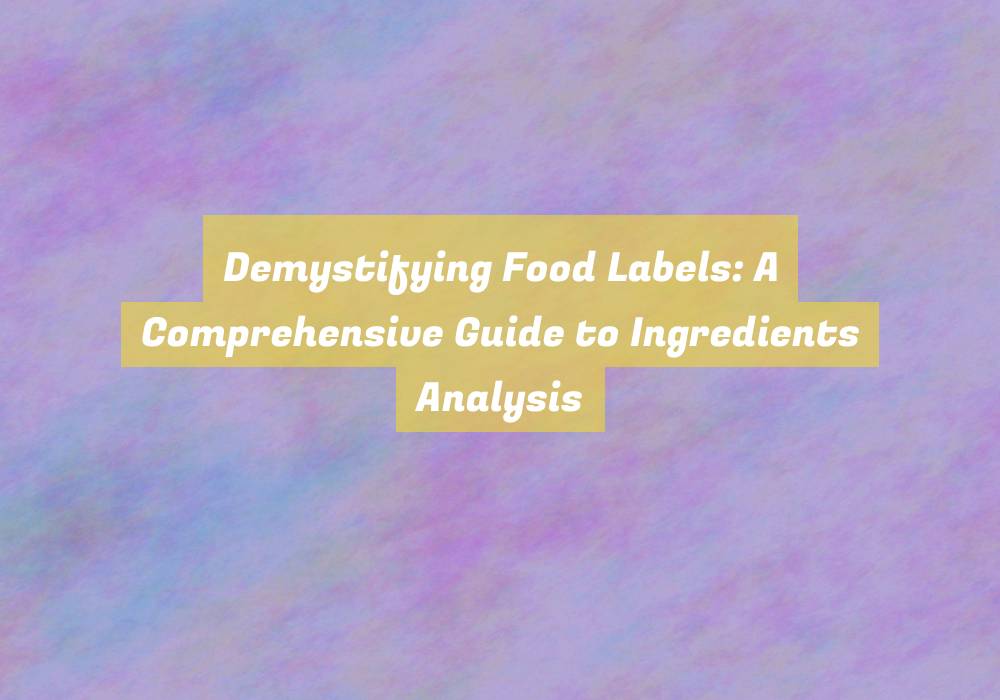Demystifying Food Labels: A Comprehensive Guide to Ingredients Analysis
You may not realize that the seemingly endless list of ingredients on your food labels can actually tell you a lot about what youG??re consuming. But understanding what those ingredients are and what they mean can be a daunting task.
However, by unpacking the regulations, decoding the ingredient lists, and identifying common allergens, you can gain a comprehensive understanding of what youG??re putting into your body. This knowledge can empower you to make more informed choices about the foods you eat.
So, letG??s navigate through the complex world of food labels and ingredients together.
Understanding Food Label Regulations
To understand food label regulations, familiarize yourself with the specific guidelines set by the relevant regulatory authorities. The Food and Drug Administration (FDA) in the United States, for example, has strict requirements for food labeling. They mandate that all ingredients be listed in descending order of predominance by weight. This means the most prominent ingredient comes first, allowing consumers to make informed decisions about the productG??s nutritional content. Additionally, the FDA requires the inclusion of certain information such as serving size, calories, and nutrients, to help consumers understand the nutritional value of the food product.
Furthermore, familiarize yourself with the regulations regarding health claims and nutrient content claims. The FDA has specific criteria for using terms such as G??low fat,G?? G??high fiber,G?? or G??reduced sodiumG?? on food labels. Understanding these guidelines will enable you to decipher the true nutritional benefits of a product, helping you make healthier choices.
Decoding Ingredient Lists
Decode food ingredient lists to understand the composition of the products you consume and make informed choices about your nutrition. When deciphering ingredient lists, focus on the first few ingredients, as they make up the majority of the product. Ingredients are listed in descending order by weight, so the first few ingredients are the most significant.
Look for recognizable, whole food ingredients rather than unfamiliar chemical compounds. Be cautious of additives, preservatives, and artificial colors or flavors, as these can indicate heavily processed foods. Additionally, be mindful of hidden sources of sugar, such as high-fructose corn syrup, dextrose, or maltose.
If you have dietary restrictions or allergies, carefully scan the ingredient list for any potential allergens. Understanding ingredient lists empowers you to make more conscious decisions about the food you consume.
Identifying Common Allergens
When examining food labels for allergens, prioritize identifying any potential sources that may conflict with your dietary restrictions or allergies, building on your understanding of ingredient lists.
Start by looking for common allergens such as peanuts, tree nuts, soy, dairy, eggs, wheat, fish, and shellfish. These allergens are often highlighted in bold or listed separately at the end of the ingredient list to draw attention to their presence.
Be aware that some ingredients may go by different names, so familiarize yourself with alternative terms for allergens. For instance, milk ingredients may be listed as casein or whey, while eggs can appear as albumin.
Additionally, be cautious of potential cross-contamination, as manufacturers are required to disclose if a product is processed in a facility that also handles common allergens.
Keep in mind that the presence of allergens can vary depending on the formulation, so always check the label, even if you have safely consumed a product in the past.
Making Informed Choices
You can empower yourself to make informed food choices by carefully evaluating the nutritional content and ingredient list on food labels. Start by focusing on the nutritional content, paying attention to key factors such as calories, fat, sugar, sodium, and protein. Consider your individual dietary needs and goals when interpreting this information.
Look for products that align with your health objectives, whether itG??s reducing sugar intake, increasing fiber, or lowering sodium consumption. Next, shift your focus to the ingredient list. Be cautious of overly processed foods with lengthy, unrecognizable ingredients. Opt for products with simple, whole-food ingredients and minimal additives. This can help you make healthier choices and avoid unnecessary chemicals and preservatives.
Additionally, keep an eye out for allergens or specific ingredients you aim to avoid. By understanding and analyzing food labels, you can take control of your diet and make choices that support your overall well-being. Remember, the power to make informed choices lies in your hands when you take the time to decipher food labels accurately.
Conclusion
Now that youG??ve learned how to decipher food labels, you can make more informed choices about the products you buy.
By understanding food label regulations, decoding ingredient lists, and identifying common allergens, you can take control of your diet and make healthier choices for you and your family.
DonG??t let confusing labels keep you from making the best choices for your health G?? armed with this knowledge, you can confidently navigate the grocery store aisles.






